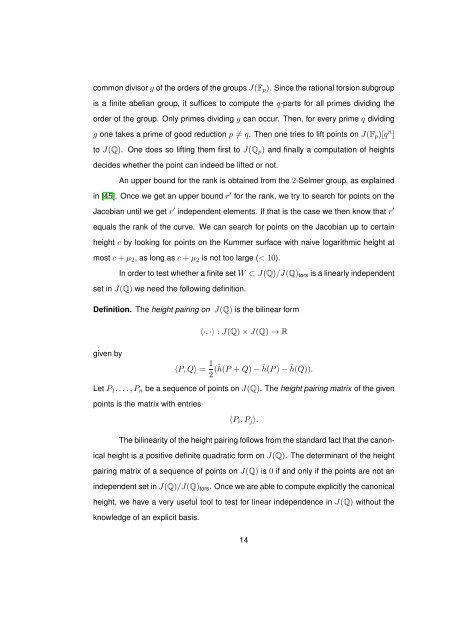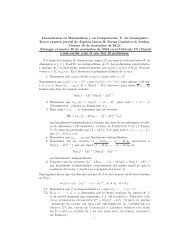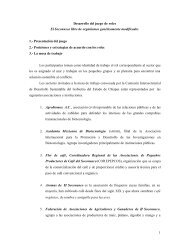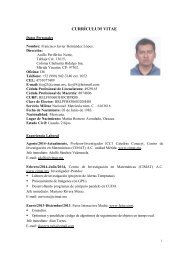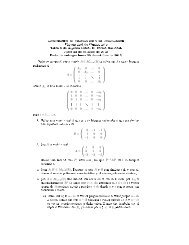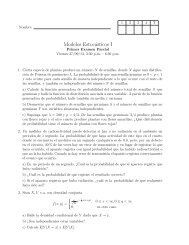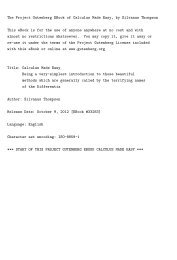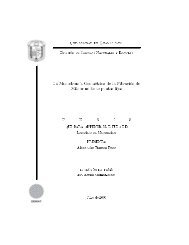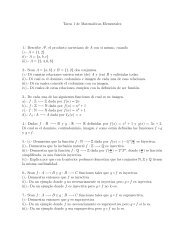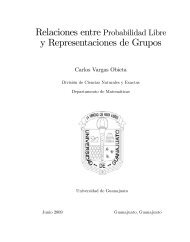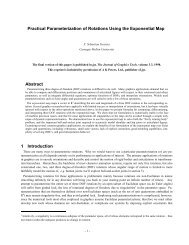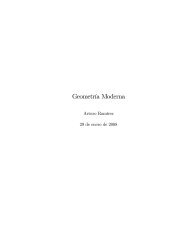S-integral points on hyperelliptic curves Homero Renato Gallegos ...
S-integral points on hyperelliptic curves Homero Renato Gallegos ...
S-integral points on hyperelliptic curves Homero Renato Gallegos ...
- No tags were found...
You also want an ePaper? Increase the reach of your titles
YUMPU automatically turns print PDFs into web optimized ePapers that Google loves.
comm<strong>on</strong> divisor g of the orders of the groups J(F p ). Since the rati<strong>on</strong>al torsi<strong>on</strong> subgroupis a finite abelian group, it suffices to compute the q-parts for all primes dividing theorder of the group. Only primes dividing g can occur. Then, for every prime q dividingg <strong>on</strong>e takes a prime of good reducti<strong>on</strong> p ≠ q. Then <strong>on</strong>e tries to lift <str<strong>on</strong>g>points</str<strong>on</strong>g> <strong>on</strong> J(F p )[q n ]to J(Q). One does so lifting them first to J(Q p ) and finally a computati<strong>on</strong> of heightsdecides whether the point can indeed be lifted or not.An upper bound for the rank is obtained from the 2-Selmer group, as explainedin [45]. Once we get an upper bound r ′ for the rank, we try to search for <str<strong>on</strong>g>points</str<strong>on</strong>g> <strong>on</strong> theJacobian until we get r ′ independent elements. If that is the case we then know that r ′equals the rank of the curve. We can search for <str<strong>on</strong>g>points</str<strong>on</strong>g> <strong>on</strong> the Jacobian up to certainheight c by looking for <str<strong>on</strong>g>points</str<strong>on</strong>g> <strong>on</strong> the Kummer surface with naive logarithmic height atmost c + µ 2 , as l<strong>on</strong>g as c + µ 2 is not too large (< 10).In order to test whether a finite set W ⊂ J(Q)/J(Q) tors is a linearly independentset in J(Q) we need the following definiti<strong>on</strong>.Definiti<strong>on</strong>. The height pairing <strong>on</strong> J(Q) is the bilinear form〈·, ·〉 : J(Q) × J(Q) → Rgiven by〈P, Q〉 = 1 (ĥ(P + Q) − ĥ(P ) − ĥ(Q)).2Let P 1 , . . . , P n be a sequence of <str<strong>on</strong>g>points</str<strong>on</strong>g> <strong>on</strong> J(Q). The height pairing matrix of the given<str<strong>on</strong>g>points</str<strong>on</strong>g> is the matrix with entries〈P i , P j 〉.The bilinearity of the height pairing follows from the standard fact that the can<strong>on</strong>icalheight is a positive definite quadratic form <strong>on</strong> J(Q). The determinant of the heightpairing matrix of a sequence of <str<strong>on</strong>g>points</str<strong>on</strong>g> <strong>on</strong> J(Q) is 0 if and <strong>on</strong>ly if the <str<strong>on</strong>g>points</str<strong>on</strong>g> are not anindependent set in J(Q)/J(Q) tors . Once we are able to compute explicitly the can<strong>on</strong>icalheight, we have a very useful tool to test for linear independence in J(Q) without theknowledge of an explicit basis.14


